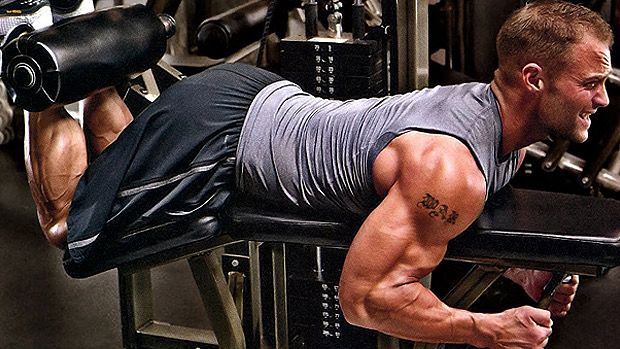Muscle actions modalities are represented as (i) isometric muscle action that involves no change in muscle length, (ii) concentric muscle actions that involve the shortening of muscle tissue, and (iii) eccentric muscle actions that implicate the active lengthening of muscle tissue against an external force or load.

During concentric contractions, the tension of the muscle rises to meet the resistance and remains stable as the muscle shortens. On the other hand, during eccentric contractions, the muscle lengthens as the resistance gradually becomes greater than the force that the muscle is capable of producing
Interestingly, it’s the eccentric or negative phase of a weight-training rep that gives you the most bang for your buck when you know how to use this phase properly.
When directly compared, eccentric muscle actions are able to produce greater force in amounts estimated to be 20–60% greater than force levels generated during concentric activities. Evidence surrounding muscle damage (loss of force production, increased soreness, etc. are routinely reported to a greater extent when eccentric actions are completed.
Eccentric resistance training incorporating submaximal, maximal (100% one repetition maximum [1RM]), or supramaximal (typically 105–120% 1RM) training loads has been shown to stimulate greater increases in maximal muscle strength in traditional activities involving both concentric and eccentric actions, compared with conventional types of strength training.
One of the first research observations with eccentric muscle actions was examined in 1882 by Fick, when he discovered that a contracting muscle under stretch could produce a greater force than a shortening muscle contraction. About fifty years later, A.V. Hill (who became a Nobel laureate) ascertained that the body had a lower energy demand when doing an eccentric muscle action as compared to a concentric muscle action.
Nautilus founder, Arthur Jones, & legendary Mike Mentzer, and eventually a lot of HIT proponents, were big supporter of eccentric training, and incorporated slow eccentrics in their workouts, quite often.

A 2017 meta-analysis study, found that, on average, eccentric training produced greater increases in hypertrophy compared with concentric training (10.0 vs. 6.8%, respectively). However, the hypertrophic advantage of eccentric training was relatively small. Given that maximal strength in eccentric training is approximately 20–50% greater than that of concentric training, it can be speculated that the greater amount of work performed during eccentric actions may be responsible for differences in muscle growth.
A 2008 meta-analysis, suggested that compared with concentric training, eccentric training may be associated with greater improvements in both total and eccentric strength in healthy individuals. In addition, eccentric training appeared to be more effective in promoting overall increases in muscle mass. The effectiveness of eccentric training in promoting strength gains is possibly mediated by the capacity to achieve higher forces during eccentric muscle actions.
A 2022 systematic review of 18 studies, found that, eccentric training is an effective method for changes in muscle architecture, leading to both flexibility and strength improvements for the lower limb.
Although both concentric and isometric muscle contractions elicit a hypertrophy response, numerous studies have reported that eccentric actions may have the greatest effect on skeletal muscle growth. Here are the benefits of eccentric training:
- Importantly, some studies indicate that the speed of the eccentric action may preferentially impact hypertrophic changes. In addition, eccentric training has been shown to lead to increased hypertrophy for both concentric-only strength and eccentric-only strength.
Slower eccentrics are surely beneficial, but too slow haven’t shown any special benefits. A 2022 study, evaluated the effects of altering the duration of the eccentric phase on muscle hypertrophy and strength of the quadriceps femoris. Ten healthy young adults (8 men and 2 women) performed unilateral knee extension exercise, whereby each leg was randomly allocated to perform the eccentric phase of movement with a duration of either 2 seconds or 4 seconds.
The study concluded that both a 2 second and 4 second eccentric duration promote similar improvements in whole muscle hypertrophy and strength of the lower limbs. The greater TUT in 4 second, was not a key modulator in altering general muscular adaptations. The slower eccentric duration showed a beneficial effect on hypertrophy of the vastus medialis muscle, indicating that varying eccentric duration may help to promote favourable muscle growth in this aspect of the quadriceps femoris.
- With eccentric exercise, greater force output is produced during a maximal eccentric action primarily because of the ability to use higher external loads.

- In addition, the energy cost of eccentric exercise is comparably low, despite the high muscle force being generated, i.e. you spend less energy during the eccentric phase of the movement, as compared to concentric. This makes eccentrics an appealing strategy for those wishing to gain additional strength and hypertrophy because of the fact that more volume can be performed without excessive fatigue
- Eccentric exercise is also linked to more robust increases in protein synthesis as well as a larger rise in IGF-1 when compared with concentric muscle actions.
- Eccentric training sessions elicit greater muscle damage compared with concentric training. The degree of eccentric-induced muscle damage is greater in upper-limb musculature when compared with lower limb.
- Evidence also indicates that a fibre-type specific response to muscle damage may occur whereby type II muscle fibres (fast twitch) seem to be more vulnerable to damage during eccentric exercise than type I muscle fibres (slow twitch).
Eccentric training, specifically eccentric overload, has been shown to generate greater motor unit recruitment specifically that of fast-twitch muscle fibres as well as the rate of force development leading to greater amounts of generated mechanical tension throughout the muscle.
These improvements along with changes in the elastic properties of the musculotendinous unit, contribute to the increases in speed, power & strength. Furthermore, eccentric training has been shown to improve an athlete’s efficiency of movement in that they are better capable of absorbing potential energy during the eccentric phase of movement and then exerting in concentrically
- Incorporating eccentric training and programming into a resistance training program can facilitate numerous benefits that extend well beyond simple increases in strength and hypertrophy for populations ranging from athletes desiring peak performance to clinical patients involved in physical rehabilitation.
For example, the aging process results in a progressive and continual reduction in muscle strength. For this reason alone, incorporation of eccentric training could be considered in an elderly population for its known ability to improve muscle strength and power while also reducing their risk for falls and potential fracture risk.
A 2022 meta-analysis study, found that, eccentric exercise is superior to, or at least as good as concentric exercise for preserving health and overall function in older adults.

Eccentric focused exercises have commonly been prescribed as a rehabilitation method for the treatment of a number of injuries, specifically overuse injuries including rehabilitation of tendinopathies, muscle strains, and anterior cruciate ligament (ACL) injuries, in which you have chronic inflammation or pain in the soft-tissue that surrounds your muscles and joints. Eccentric training has been found to be a highly effective method for improving the size and quality of soft-tissue, reducing pain in the affected limbs and improving return to play success.
Research has shown eccentric training to be an effective method of reducing both new and recurring injuries. The majority of injuries in sport happen eccentrically during decelerative movement. If we cannot handle the amount of force we are attempting to absorb eccentrically, the body will compensate to deal with the stress which can then lead to injuries. It is logical that if we have the eccentric strength to handle greater forces as our muscles lengthen and we improve the quality of our connective tissue we would be less likely to be injured.
- With respect to increases in power, eccentric exercise training serves an important part in all aspects of sports, that involve jumping, running, or throwing as a critical part of the stretch-shortening cycle, and has been shown to be an effective modality in increasing (explosive) muscle strength & muscle cross-sectional area.
- Also, studies have found that eccentric training have the same impact on men and women.
There are many ways you can use to incorporate eccentric training in your schedule, but the simplest and the most commonly practiced technique is the Super Slow technique. The lifter executes an exaggerated slow-speed eccentric phase while concentrically lifting the bar explosively.
Athletes should try to visualize their muscles as giant brake systems that decelerate the resistance. And the greater the range of motion in the exercise, the longer the lowering time.
Slow and controlled eccentric repetitions are beneficial for the muscle to stay under tension for a longer time. Muscle fibres stretch further while contracting.
Workout by resisting force on the eccentric portion of an exercise. Avoid letting the weight return to the starting position for as long as possible. Purposefully increasing the time the muscle is under this stress will help your clients generate a higher amount of force and build greater strength over time.

It should be emphasized that the eccentric duration varies depending on the load used. For example, a lower % 1RM yields a longer eccentric duration (i.e., 60% 10–12 seconds), whereas a heavier load (i.e., 85%) would likely yield approximate 4-second eccentric action duration. A load ranging from 60 to 85% 1RM is commonly used with eccentric action durations ranging from 2 to 15 seconds, depending on load assignment, type of movement, size of muscle group, etc. A rest period of 60 seconds is commonly used.
Also, during the end of the set, to further push the intensity, you can ask a spotter/partner to support the concentric portion of the rep, and you lower the bar yourself.
However, as eccentric training, increases DOMS, one should avoid the use of near-maximal or maximal eccentric muscular contractions that when designing exercise programs for novice clients.



